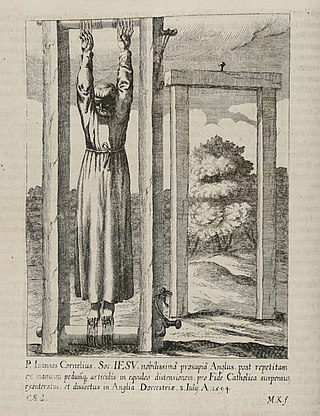Related Research Articles

The Forty Martyrs of England and Wales or Cuthbert Mayne and Thirty-Nine Companion Martyrs are a group of Catholic, lay and religious, men and women, executed between 1535 and 1679 for treason and related offences under various laws enacted by Parliament during the English Reformation. The individuals listed range from Carthusian monks who in 1535 declined to accept Henry VIII's Act of Supremacy, to seminary priests who were caught up in the alleged Popish Plot against Charles II in 1679. Many were sentenced to death at show trials, or with no trial at all.

Edmund Arrowsmith, SJ was one of the Forty Martyrs of England and Wales of the Catholic Church. The main source of information on Arrowsmith is a contemporary account written by an eyewitness and published a short time after his death. This document, conforming to the ancient style of the "Acts of martyrs" includes the story of the execution of another 17th-century recusant martyr, Richard Herst.

Henry Heath (1599–1643), religious name Paul of St. Magdalene, was an English priest of the Order of Friars Minor and a Roman Catholic martyr.
John Woodcock (1603–1646) was a Franciscan priest from Lancashire executed in August 1646 under the Jesuits, etc. Act 1584 for being a priest and present in the realm.

The Eighty-five Martyrs of England and Wales, also known as George Haydock and Eighty-four Companion Martyrs, are a group of men who were executed on charges of treason and related offences in the Kingdom of England between 1584 and 1679. Of the eighty-five, seventy-five were executed under the Jesuits, etc. Act 1584.
Robert Nutter was an English Catholic priest, Dominican friar and martyr. He was beatified in 1987.
Francis Ingleby was a Roman Catholic martyr executed in York, England during the reign of Elizabeth I.

John Cornelius also called Mohun, was an Irish Catholic priest and Jesuit born in Cornwall. He is a Catholic martyr, beatified in 1929.

Stephen Rowsham was an English Catholic priest, executed on 3 April 1587. He is a Catholic martyr, and was beatified by Pope John Paul in 1987.
Ralph Crockett was an English Roman Catholic priest. He is a Catholic martyr, beatified in 1929.
William Harrington was an English Jesuit priest. He is a Roman Catholic martyr, beatified in 1929.
Anthony Page was an English Catholic priest. He is a Catholic martyr, beatified in 1987.
Robert Thorpe was an English Roman Catholic priest. He is a Catholic martyr, beatified in 1987.
John Speed was an English Roman Catholic layman, condemned for aiding and abetting Catholic priests in their ministry. He is a Catholic martyr, beatified by Pope Pius XI in 1929.
Joseph Lambton (1569–1592) was an English Catholic priest. He is honoured as a Catholic martyr, beatified in 1987.
Richard Sergeant (executed at Tyburn, 20 April 1586) was an English Roman Catholic priest. He is a Catholic martyr, beatified in 1987.
Richard Martin was an English martyr. A layman, Martin was charged with being a "receiver and maintainer of priests" for having bought supper for Robert Morton, a priest.
Nicholas Woodfen born Nicholas Wheeler, also known as Nicholas Devereux, was an English Roman Catholic priest who was hanged, drawn and quartered at Tyburn, London on 21 January 1586. He is considered a Catholic martyr and one of the Eighty-five martyrs of England and Wales who were executed between 1584 and 1679. He was beatified on 22 November 1987 by Pope John Paul II.
During the English Reformation, a number of believers were executed at Lancaster in England as a consequence of their Catholic faith. They are commonly referred to as the Lancaster Martyrs and are commemorated locally by the Lancaster Martyrs Memorial Stone which may be found close to the centre of Lancaster city.
References
- Attribution
 This article incorporates text from a publication now in the public domain : Herbermann, Charles, ed. (1913). "Ven. Hugh Taylor". Catholic Encyclopedia . New York: Robert Appleton Company.
This article incorporates text from a publication now in the public domain : Herbermann, Charles, ed. (1913). "Ven. Hugh Taylor". Catholic Encyclopedia . New York: Robert Appleton Company.